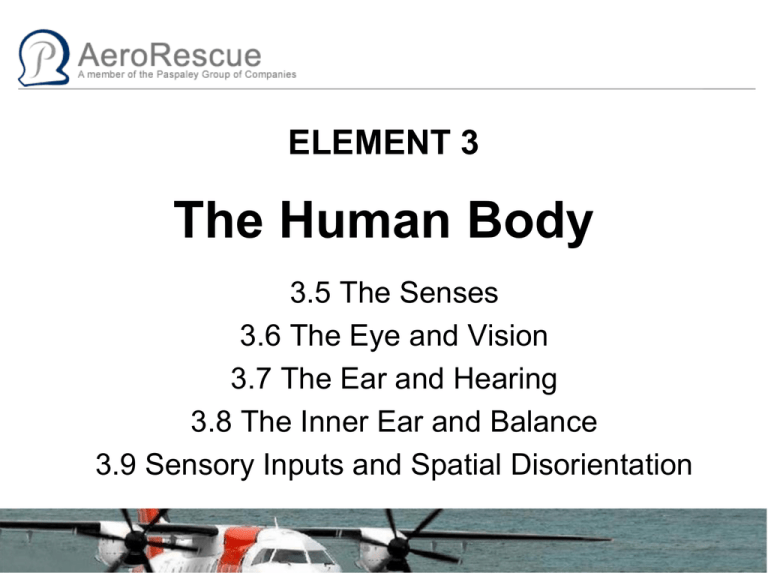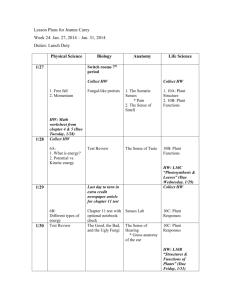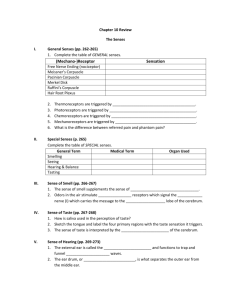Pt 3 Click Here
advertisement

ELEMENT 3 The Human Body 3.5 The Senses 3.6 The Eye and Vision 3.7 The Ear and Hearing 3.8 The Inner Ear and Balance 3.9 Sensory Inputs and Spatial Disorientation AIM & END STATE • Aim: – To discuss the senses and how they relate to human performance limitations • End state: – A greater understanding of the human body’s strengths and weaknesses • References: In the CRM Reference Manual. 3.0 SENSES • How many senses do we have? – Classic senses are five but perhaps up to 21 – Nine senses are commonly agreed upon and are tested in aircrew medicals • A sense is an ability to interpret information about our environment that has been detected through a sensor, eg chemorecptors in the nose. 3.5 SENSES • The extra senses we shall investigate: – Equilibrioception – balance – Thermoception – ability to detect heat/cold – Proprioception – ability to tell where the body is in relation to the environment – Nocioception – ability to detect pain. • Equilibrioception and Proprioception are tested by aviation physicians during aircrew medicals. 3.5.1.2 SENSES • Sensory Thresholds – The limit of the ability to detect a change in a stimulus: Absolute, Recognition, Differential, Terminal. • Sensory Sensitivity – Detection ability (1st meaning) or a disorder where a person experiences a debilitating sensory overload from everyday experiences, eg touching fabric or a bad smell. 3.5.2 SENSORECEPTORS • Stimuli detected through SensoReceptors: 3.5.4 THE EYE • Most important sensor for humans • More than 80% of our sensory information about our environment comes through our eyes. 3.6 THE EYE • Light passes through the cornea and lens and falls upon the retina, focussing in particular on the fovea centralis • Accommodation is the way the lens is bent by ciliary muscles to focus light. 3.6.2.1 THE EYE • Rods and Cones are photoreceptors that detect light – Cones detect colour and detail – day/central vision – Rods detect low light levels and movement night/peripheral vision • Rhodopsin and Iodopsin are two chemicals that help in light detection. 3.6.2.2 THE EYE • Visual Acuity (VA) is the ability to discriminate the fine details of an object thus is a requirement of depth perception • VA is measured as a fraction (20/20 imp 6/6 metric) – 20/40 or 6/12 is half as good as the average • VA can be affected by disorders such as – Myopia (shortsightedness) – Hyperopia (long sightedness). 3.6.3 THE EYE • Presbyopia – Loss of VA due to age – Becomes very noticeable in a person’s 40s – Reduction in suppleness of the lens and weakness in the ciliary muscles causes a reduction in accommodation – Hard to read fine print; things are a little blurry; hard to focus between distances; eye strain after reading for a long time. 3.6.3.2 THE EYE • Visual Field – What a person can see. Depends on light falling on the retina (central and peripheral vision) • Binocular Vision – FOV 200 deg both eyes; 160 deg one eye – Uses parallax error for depth perception to approx 12m – Provide Visual Summation: two eyes are 41% more effective at detecting stimuli than one eye. 3.6.4 THE EYE • Depth Perception: the ability to estimate distances without measuring them – Relative Size – Interposition – Linear Perspective – Aerial Perspective – Light and Shade – Monocular Movement Parallax 3.6.4.2 THE EYE • Blind Spots: areas on the retina that do not receive light information – Day Blind Spot: • Optic Disc • No cones – Night Blind Spot • Fovea Centralis • No rods • Offset vision by 10-20 deg. 3.6.5 THE EYE • Glaucoma: Pressure build up in the corneal area (anterior and posterior chambers) causes damage to the fovea – Usually gradual – Can easily be checked – Easily fixed if caught early before damage to retina is done. 3.6.6 THE EYE • Hypoxia and Colour Vision: Vision affected by loss of oxygen, especially at night – 10% at 5,000’ and 28% at 10,000’ PA especially during mesopic (dawn/dusk) periods – Breathing oxygen increases visual acuity and colour discrimination. 3.6.7 THE EAR • The Ear: Primary organ of audition; second most important organ for humans – Detects sounds – Inner ear detects balance – Pressure waves in the air (sound waves) are caught by the pinna, funnelled into the auditory canal to the eardrum which vibrates. 3.7 THE EAR – The vibrations are transmitted through the ossicles to the cochlea where they are detected by mechanoreceptors that induce a signal to the brain – Semi-Circular Canals detect movement by detecting radial and linear accelerations. 3.7.1 THE EAR • Hearing Loss: Two main categories: – Conductive • Damage or blockage due to injury or disease to the outer and/or middle ear – Sensorineural • Usually caused by damage to the inner ear’s stereocilia cells due to exposure to loud noise. 3.7.3 THE EAR • Noise Induced Hearing Loss: – Part of the speech range in the audible range is first to go. 3.7.3 THE EAR • Balance: Equilibrioception is through the organs of the inner ear – Semi-Circular Canals arranged in x,y,z axes – Otoliths arranged in x,y axes in utricle – Detects movement by relative movement of endolymph fluid in SCC or by small crystals in gelatinous mix in utricle. 3.7.3 DISORIENTATION • Spatial Disorientation (SD) is the inability of the operator (eg pilot) to understand where the apparatus (eg aircraft) is in relation to the earth. • Usually due to poor interpretation of, or weak sensory stimuli, especially: – Vision, Equilibrioception and Proprioception • ATSB says that the career incidence of SD occurs to 90 to 100% of pilots… (it will happen to you) 3.9 DISORIENTATION • Types of SD: – Type 1: SD is not recognised by individual • Acft usually remains under control but is flown into a dangerous situation (eg terrain) – Type 2: SD is confusing but not incapacitating • Operator knows something is wrong. Information does not correlate with what the body/mind is saying – Type 3: SD is incapacitating, potentially fatal • Operator is physically/psychologically overwhelmed and is usually unable to recover from the situation. 3.9.1 DISORIENTATION • Vertigo – usually associated with an abnormality in the vestibular organ. Similar effect to SD – Flicker vertigo: caused by flashing light 1 Hz to 20 Hz – Often in helicopter ops: • Front seats occupants or patients lying in rear where the sun can flicker through rotor blades. 3.9.2 DISORIENTATION • Pressure Vertigo – due to imbalance in pressure between middle ears – often due to imbalanced valsalva attempt • Medical Vertigo – usually due to temporary problem in middle ear • All types of vertigo will cause dizziness, nausea and disorientation to some degree • Can happen to anyone at anytime. 3.9.2 DISORIENTATION • Categories of SD: – Somatogyral: Dark Night Take Offs – Somatogravic: Graveyard spiral – Visual: Illusions causing SD 3.9.3 DISORIENTATION • Black Hole Approach: Illusion of excessive altitude when there are no lights below the aircraft during an approach – Often leads to incorrect control inputs • Boeing study found that 52% of accidents/fatalities occur during the last 4% of flight (approach/landing phase) – Most of those were due to pilot error when no precision approach aid (glidepath) was used. 3.9.3




